[English] 日本語
 Yorodumi
Yorodumi- PDB-7ata: Nudaurelia capensis omega virus procapsid: virus-like particles e... -
+ Open data
Open data
- Basic information
Basic information
| Entry | Database: PDB / ID: 7ata | ||||||||||||
|---|---|---|---|---|---|---|---|---|---|---|---|---|---|
| Title | Nudaurelia capensis omega virus procapsid: virus-like particles expressed in Nicotiana benthamiana | ||||||||||||
 Components Components | (p70) x 2 | ||||||||||||
 Keywords Keywords | VIRUS LIKE PARTICLE / ICOSAHEDRAL VIRUS / AUTO-CATALYTIC CLEAVAGE / VIRUS MATURATION / TRANSIENT EXPRESSION | ||||||||||||
| Function / homology | Peptidase N2 / Peptidase family A21 / Viral coat protein subunit / p70 Function and homology information Function and homology information | ||||||||||||
| Biological species |   Nudaurelia capensis omega virus Nudaurelia capensis omega virus | ||||||||||||
| Method | ELECTRON MICROSCOPY / single particle reconstruction / cryo EM / Resolution: 6.63 Å | ||||||||||||
 Authors Authors | Castells-Graells, R. / Ribeiro, J.R.S. / Domitrovic, T. / Hesketh, E.L. / Scarff, C.A. / Johnson, J.E. / Ranson, N.A. / Lawson, D.M. / Lomonossoff, G.P. | ||||||||||||
| Funding support |  United Kingdom, 3items United Kingdom, 3items
| ||||||||||||
 Citation Citation |  Journal: Commun Biol / Year: 2021 Journal: Commun Biol / Year: 2021Title: Plant-expressed virus-like particles reveal the intricate maturation process of a eukaryotic virus. Authors: Roger Castells-Graells / Jonas R S Ribeiro / Tatiana Domitrovic / Emma L Hesketh / Charlotte A Scarff / John E Johnson / Neil A Ranson / David M Lawson / George P Lomonossoff /    Abstract: Many virus capsids undergo exquisitely choreographed maturation processes in their host cells to produce infectious virions, and these remain poorly understood. As a tool for studying virus ...Many virus capsids undergo exquisitely choreographed maturation processes in their host cells to produce infectious virions, and these remain poorly understood. As a tool for studying virus maturation, we transiently expressed the capsid protein of the insect virus Nudaurelia capensis omega virus (NωV) in Nicotiana benthamiana and were able to purify both immature procapsids and mature capsids from infiltrated leaves by varying the expression time. Cryo-EM analysis of the plant-produced procapsids and mature capsids to 6.6 Å and 2.7 Å resolution, respectively, reveals that in addition to large scale rigid body motions, internal regions of the subunits are extensively remodelled during maturation, creating the active site required for autocatalytic cleavage and infectivity. The mature particles are biologically active in terms of their ability to lyse membranes and have a structure that is essentially identical to authentic virus. The ability to faithfully recapitulate and visualize a complex maturation process in plants, including the autocatalytic cleavage of the capsid protein, has revealed a ~30 Å translation-rotation of the subunits during maturation as well as conformational rearrangements in the N and C-terminal helical regions of each subunit. | ||||||||||||
| History |
|
- Structure visualization
Structure visualization
| Movie |
 Movie viewer Movie viewer |
|---|---|
| Structure viewer | Molecule:  Molmil Molmil Jmol/JSmol Jmol/JSmol |
- Downloads & links
Downloads & links
- Download
Download
| PDBx/mmCIF format |  7ata.cif.gz 7ata.cif.gz | 388.5 KB | Display |  PDBx/mmCIF format PDBx/mmCIF format |
|---|---|---|---|---|
| PDB format |  pdb7ata.ent.gz pdb7ata.ent.gz | Display |  PDB format PDB format | |
| PDBx/mmJSON format |  7ata.json.gz 7ata.json.gz | Tree view |  PDBx/mmJSON format PDBx/mmJSON format | |
| Others |  Other downloads Other downloads |
-Validation report
| Summary document |  7ata_validation.pdf.gz 7ata_validation.pdf.gz | 1.3 MB | Display |  wwPDB validaton report wwPDB validaton report |
|---|---|---|---|---|
| Full document |  7ata_full_validation.pdf.gz 7ata_full_validation.pdf.gz | 1.3 MB | Display | |
| Data in XML |  7ata_validation.xml.gz 7ata_validation.xml.gz | 79.7 KB | Display | |
| Data in CIF |  7ata_validation.cif.gz 7ata_validation.cif.gz | 116.3 KB | Display | |
| Arichive directory |  https://data.pdbj.org/pub/pdb/validation_reports/at/7ata https://data.pdbj.org/pub/pdb/validation_reports/at/7ata ftp://data.pdbj.org/pub/pdb/validation_reports/at/7ata ftp://data.pdbj.org/pub/pdb/validation_reports/at/7ata | HTTPS FTP |
-Related structure data
| Related structure data |  11911MC  7anmC C: citing same article ( M: map data used to model this data |
|---|---|
| Similar structure data | |
| EM raw data |  EMPIAR-10555 (Title: Nudaurelia capensis omega virus procapsid: virus-like particles expressed in Nicotiana benthamiana EMPIAR-10555 (Title: Nudaurelia capensis omega virus procapsid: virus-like particles expressed in Nicotiana benthamianaData size: 1.0 TB Data #1: aligned and dose-weighted micrographs [micrographs - single frame] Data #2: aligned and non-dose-weighted micrographs [micrographs - single frame]) |
- Links
Links
- Assembly
Assembly
| Deposited unit | 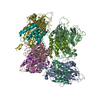
|
|---|---|
| 1 | x 60
|
- Components
Components
| #1: Protein | Mass: 62094.828 Da / Num. of mol.: 4 Source method: isolated from a genetically manipulated source Source: (gene. exp.)   Nudaurelia capensis omega virus / Production host: Nudaurelia capensis omega virus / Production host:  #2: Protein | Mass: 7815.102 Da / Num. of mol.: 4 Source method: isolated from a genetically manipulated source Source: (gene. exp.)   Nudaurelia capensis omega virus / Production host: Nudaurelia capensis omega virus / Production host:  |
|---|
-Experimental details
-Experiment
| Experiment | Method: ELECTRON MICROSCOPY |
|---|---|
| EM experiment | Aggregation state: PARTICLE / 3D reconstruction method: single particle reconstruction |
- Sample preparation
Sample preparation
| Component | Name: Nudaurelia capensis omega virus / Type: VIRUS Details: The codon-optimized sequence was transiently expressed in Nicotiana benthamiana Entity ID: #1 / Source: RECOMBINANT |
|---|---|
| Molecular weight | Value: 16.76 MDa / Experimental value: NO |
| Source (natural) | Organism:   Nudaurelia capensis omega virus Nudaurelia capensis omega virus |
| Source (recombinant) | Organism:  |
| Details of virus | Empty: NO / Enveloped: NO / Isolate: OTHER / Type: VIRUS-LIKE PARTICLE |
| Natural host | Organism: Gonimbrasia cytherea |
| Virus shell | Name: coat / Diameter: 480 nm / Triangulation number (T number): 4 |
| Buffer solution | pH: 7.6 / Details: NULL |
| Specimen | Conc.: 0.3 mg/ml / Embedding applied: NO / Shadowing applied: NO / Staining applied: NO / Vitrification applied: YES / Details: NULL |
| Specimen support | Grid material: COPPER |
| Vitrification | Instrument: FEI VITROBOT MARK IV / Cryogen name: ETHANE |
- Electron microscopy imaging
Electron microscopy imaging
| Experimental equipment |  Model: Titan Krios / Image courtesy: FEI Company |
|---|---|
| Microscopy | Model: FEI TITAN KRIOS |
| Electron gun | Electron source:  FIELD EMISSION GUN / Accelerating voltage: 300 kV / Illumination mode: FLOOD BEAM FIELD EMISSION GUN / Accelerating voltage: 300 kV / Illumination mode: FLOOD BEAM |
| Electron lens | Mode: BRIGHT FIELD / Nominal magnification: 75000 X / Nominal defocus max: 2700 nm / Nominal defocus min: 700 nm / Cs: 2.7 mm / C2 aperture diameter: 70 µm |
| Specimen holder | Cryogen: NITROGEN |
| Image recording | Average exposure time: 1.5 sec. / Electron dose: 72 e/Å2 / Detector mode: INTEGRATING / Film or detector model: FEI FALCON III (4k x 4k) / Num. of grids imaged: 1 / Num. of real images: 8554 / Details: NULL |
- Processing
Processing
| EM software |
| ||||||||||||||||||||||||||||||||||||||||||||
|---|---|---|---|---|---|---|---|---|---|---|---|---|---|---|---|---|---|---|---|---|---|---|---|---|---|---|---|---|---|---|---|---|---|---|---|---|---|---|---|---|---|---|---|---|---|
| Image processing | Details: NULL | ||||||||||||||||||||||||||||||||||||||||||||
| CTF correction | Details: NULL / Type: PHASE FLIPPING AND AMPLITUDE CORRECTION | ||||||||||||||||||||||||||||||||||||||||||||
| Symmetry | Point symmetry: I (icosahedral) | ||||||||||||||||||||||||||||||||||||||||||||
| 3D reconstruction | Resolution: 6.63 Å / Resolution method: FSC 0.143 CUT-OFF / Num. of particles: 5426 / Symmetry type: POINT | ||||||||||||||||||||||||||||||||||||||||||||
| Atomic model building | B value: 105.8 / Protocol: OTHER / Space: REAL / Target criteria: Correlation coefficient Details: The model was built and refined against a density modified map generated using phenix.resolve_cryo_em. This used the Relion half maps as inputs and improved the resolution to 6.6 Angstrom. | ||||||||||||||||||||||||||||||||||||||||||||
| Atomic model building | PDB-ID: 7ANM |
 Movie
Movie Controller
Controller



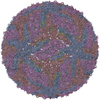




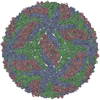
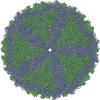

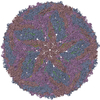

 PDBj
PDBj
